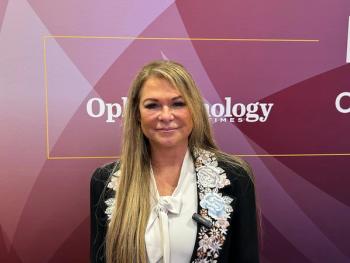
Researchers: ‘Smart’ contact lenses may one day enable wireless glaucoma detection
A team of Chinese researchers have been working on a way to continuously and more comfortably detect these tiny fluctuations in pressure, such as contact lenses that transmit signals to receptor glasses.
Often, patients with early-stage glaucoma don’t know they have it, even though early treatment is key to reducing vision loss. While detecting a subtle increase in eye pressure helps ophthalmologists diagnose glaucoma, it can be challenging to monitor continuously, especially with the variety of temperatures eyes experience.
A team of researchers reported in ACS Applied Materials & Interfaces the development of a prototype “smart” contact lens that measures eye pressure accurately, regardless of temperature.1
According to the Centers for Disease Control and Prevention, about 3 million people in the US have glaucoma.2 Currently, ophthalmologists and optometrists use air puff tests during eye examinations to get 1-time measurements of eye pressure. A slight elevation in pressure, an otherwise imperceptible symptom caused by fluid buildup around the cornea, can lead to a glaucoma diagnosis.
According to an American Chemical Society (ACS) news release, a team of Chinese researchers have been working on a way to continuously and more comfortably detect these tiny fluctuations in pressure, such as contact lenses that transmit signals to receptor glasses. There are hurdles, such as changing temperatures — like stepping outside into cold weather — which can throw off the lenses’ measurements. Dengbao Xiao, with the Institute of Advanced Structure Technology, Beijing Institute of Technology, and colleagues wanted to develop a contact lens that accurately measures and wirelessly transmits real-time signals about eye pressure across a wide range of temperatures.3
The researchers noted the WMCL’s compact circuitry design allows for the integration of low-frequency and high-frequency resonators within a single layer of a sensing circuit and does not impact the vision of the wearer.
“Mechanically guided microscale 3D encapsulation strategy combined with flexible circuit printing techniques achieves the surface-adaptive fabrication of the WMCL,” the researchers wrote.
“We developed an intelligent wireless measuring contact lens (WMCL) incorporating a dual inductor-capacitor-resistor (LCR) resonant system to achieve temperature self-compensation for quantitative IOP monitoring in different application environments,” the researchers wrote.
The ACS reported in its news release the researchers developed a pair of miniature spiral circuits, each with a unique natural vibration pattern that would change when stretched by minute amounts, such as with changes to an eye’s pressure and diameter.
To create pressure-detecting contact lenses, the researchers sandwiched these tiny circuits between layers of polydimethylsiloxane, a typical contact lens material. The researchers then wirelessly read the embedded circuits’ vibration patterns by holding a coil near the lens that was connected to a computer. The transmitted signals were unaffected by tests meant to mimic eye movement, extended exposure to moisture (to simulate damp conditions in the eye), and daily wear and tear.
The researchers noted the WMCL’s compact circuitry design allows for the integration of low-frequency and high-frequency resonators within a single layer of a sensing circuit and does not impact the vision of the wearer.
“Mechanically guided microscale 3D encapsulation strategy combined with flexible circuit printing techniques achieves the surface-adaptive fabrication of the WMCL,” the researchers wrote.
Moreover, during tests in the lab, the researchers placed the lenses on the eyes of 3 individual pig eye specimens while controlling the ocular pressures and temperatures. The contact lenses were monitored and wirelessly transmitted pressure data from 50 to 122 degrees F.
The researchers found that when pressures were calculated from the signal of only 1 circuit in the lens, the results deviated up to 87% from the true values. However, when information from both circuits was used, the pressure readings differed by only 7% from the true value because the combination removed temperature-related errors. The researchers say that their dual-circuit “smart” lens design has the potential to be used for accurate early detection and monitoring of glaucoma, even in a wide range of temperatures.1,3
“The WMCL demonstrates outstanding sensitivity and linearity in monitoring the IOP of porcine eyes in vitro while maintaining satisfactory measurement accuracy even with internal temperature variations exceeding 10° C,” the researchers concluded. “Overcoming the impact of temperature variations on IOP monitoring from the system level, the WMCL showcases immense potential as the next generation of all-weather IOP monitoring devices.”
The authors acknowledge funding from the National Natural Science Foundation of China.3
References:
Li X, Chen W, Chen W, et al. Temperature Self-Compensating Intelligent Wireless Measuring Contact Lens for Quantitative Intraocular Pressure Monitoring. ACS applied materials & interfaces. Published online April 23, 2024. Accessed May 13, 2024. DOI: doi:https://doi.org/10.1021/acsami.4c02289
CDC. Current Glaucoma Programs. Centers for Disease Control and Prevention. Published January 22, 2021. Accessed May 13, 2024. https://www.cdc.gov/visionhealth/research/projects/ongoing/glaucoma.htm#:~:text=Currently%2C%20there%20is%20no%20cure
“Smart” contact lenses could someday enable wireless glaucoma detection. EurekAlert! Accessed May 13, 2024. https://www.eurekalert.org/news-releases/1044150
Newsletter
Don’t miss out—get Ophthalmology Times updates on the latest clinical advancements and expert interviews, straight to your inbox.



















































.png)


